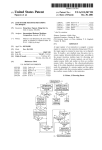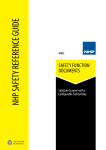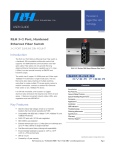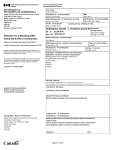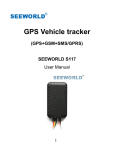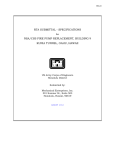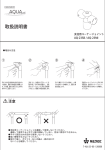Download Fabric network management and diagnostic tool
Transcript
l|||||||||||||ll||l||||||||l||||||||l|||||||||||||||||||l||||||||||||l|||||||||||||||||||| US 20060026275A1 (19) United States (12) Patent Application Publication (10) Pub. N0.: US 2006/0026275 A1 Gilmour et al. (54) (43) Pub. Date: FABRIC NETWORK MANAGEMENT AND Feb. 2, 2006 Publication Classi?cation DIAGNOSTIC TOOL (51) Int. Cl. G061: 15/173 (76) Inventors: David Alexander Gilmour, Almonte (CA); Harvey Parisien, Ottawa (CA) (52) (200601) US. Cl. ............................................................ .. 709/223 Correspondence Address: TEITELBAUM & MACLEAN 1187 BANK STREET, SUITE 201 57 OTTAWA, ON K1S 3X7 (CA) (21) Appl. No.: 11/188,928 (22) Jul 26 2 005 Filed . I ABSTRACT ( ) The invention relates to a maintenance and diagnostic tool ’ for embedded fabric networks providing an interactive Related US Application Data graphical user interface for displaying, monitoring and man (60) Provisional application No. 60/591,081, ?led on Jul. 27, 2004. aging processing elements’ Such as microprocessors’ switches, bridges and memory, within the EF network. 24 21 26 \ 21 7 Fromm ' vdlh Emho?dd “in?! l ‘mm M“m"' '90“ r m‘I'I?dll1 :1 u u: Tm o . mum‘ rm Tundra hum 29 /M Mal,” *5 22 21 K ( r m s u u . u Poaaao r in s ulu n new "o. mm" I | I'lll?ul “PM IIIRSEIIQEMPW 1 FIIISHI 11PM Swill RapldiO Proms“ L Serial RapldlO Pwccmv am-o Patent Application Publication Feb. 2, 2006 Sheet 1 0f 12 US 2006/0026275 A1 E 5F£a82m E ..ovx.WOhx. 2 5 2m 0H.23mi 2 Patent Application Publication Feb. 2, 2006 Sheet 2 0f 12 US 2006/0026275 Al Patent Application Publication Feb. 2, 2006 Sheet 3 0f 12 om\5-83: ‘2goinr5w: iE“0n9o3w5u2:1i 2‘0839>15 EswEm EswEv US 2006/0026275 A1 Patent Application Publication a2% Feb. 2, 2006 Sheet 4 0f 12 US 2006/0026275 A1 \ A x @Nw PmmSwE Patent Application Publication ??3S ‘8593:. / \ 302.:53:.28a ?wam Eswiw Feb. 2, 2006 Sheet 5 0f 12 US 2006/0026275 A1 To_ £08953 “S .1;. Patent Application Publication Feb. 2, 2006 Sheet 6 0f 12 US 2006/0026275 A1 QN N IEH_6n5e9:3m“a. gae?!“ 283Q:1. mNN ‘0 35 2505.3:8“; Eswiw 25850.38;1 5083. @N N xloeuo Patent Application Publication 0mm @wHswE Feb. 2, 2006 Sheet 7 0f 12 US 2006/0026275 A1 Patent Application Publication H6$E:.a_E5.P79:.E 959ma Feb. 2, 2006 Sheet 8 0f 12 US 2006/0026275 A1 Patent Application Publication com Feb. 2, 2006 Sheet 9 0f 12 US 2006/0026275 A1 Patent Application Publication Feb. 2, 2006 Sheet 12 0f 12 US 2006/0026275 A1 8.23 ,hmuaw gon-2.0835: gCuncshaot;m 20:59m OOQOOOOQ ‘s’! Q Feb. 2, 2006 US 2006/0026275 A1 FABRIC NETWORK MANAGEMENT AND DIAGNOSTIC TOOL CROSS-REFERENCE TO RELATED APPLICATIONS [0001] The present invention claims priority from US. Patent Application No. 60/591,081 ?led Jul. 27, 2004, Which is incorporated herein by reference. TECHNICAL FIELD [0002] The present invention relates to a system for graphically illustrating, designing, managing and monitor ing an embedded fabric-based system, and in particular to softWare providing a graphic user interface (GUI) for net Work management of a sWitched fabric based system. BACKGROUND OF THE INVENTION [0003] Currently, fabric-based systems, eg RapidIO (RIO), PCI Express (PCIe), and Advanced SWitching Inter connect (ASI), require deep technical knoWledge of the protocol and softWare to be able to initiate and extract information therefrom. RIO, PCIe and ASI architectures are electronic data communications standards for interconnect ing chips on a circuit board and circuit boards using a different Ways, so you Would need to memoriZe codes or have reference manuals at the ready for each device. [0006] In order for the registers in remote parts of the system to be monitored or edited one or more command line functions Would have to be manually entered, including the data needed to tell the computer Which node in the netWork you Wish to interrogate and Which register address you Wish to read. Subsequently, the register contents/value Would be provided, Which Would require the user to manually interpret the data to understand What the values mean. Similarly, system performance monitoring could only be executed through the use of one or more command line functions to obtain performance register values, Which Would have to be manually interpreted to understand What the values mean. [0007] VisualiZing data paths Was not possible in conven tional system; hoWever, the information could be manually gathered through multiple command line functions, and the manual interpretation of the output to provide the user With data path information. Similarly, routing table data could only be obtained through the use of one or more command line functions, and the manual calculation of the appropriate hop counts and identifying destination IDs. [0008] NetWork management softWare is common to LAN/WAN type netWorks, in Which nodes are pieces of backplane. The RapidIO architecture, for example, is computer systems, eg Servers, routers, gateWays; hoWever, designed to be used for the processor and peripheral inter face Where bandWidth and loW latency are crucial. RapidIO, a fully interactive netWork management and diagnostic tool for processing elements, eg processors, memory, bridges like ASI, Was designed for embedded systems, primarily for netWorking and communications equipment, enterprise stor age, and other high-performance embedded markets. PCIe, and sWitches, has never existed in the embedded World. Conventional netWork management softWare provides a While originally developed for the Server market, is noW also ?nding applications Within the embedded systems. In addition to technical requirements, the high-performance embedded market requires an open standard interconnect. Currently, the market suffers from an overabundance of proprietary buses, requiring standard product and ASIC based bridges to connect the various devices in the system. The RapidIO interconnect provides a common connection architecture for general purpose RISC processors, digital signal processors, communications processors, netWork pro cessors, memory controllers, peripheral devices, and bridges to legacy buses, Which bene?ts users by reducing cost, time-to-market, and complexity. [0004] Existing fabric-based technology tools provide a picture of an element in a netWork map; hoWever, to interact With the element the machine address and the sp eci?c register addresses and offsets must be knoWn and speci?ed. [0009] An object of the present invention is to overcome the shortcomings of the prior art by providing a user interface, Which not only extracts the information relating to the elements of a fabric embedded netWork, but analyZes and graphically illustrates the information providing design, monitoring and management functionality. Another object of the present invention is to provide the user With a fully interactive netWork map, Which enables the user to visually select any processing element from Within the map, and, by using a variety of mouse/button initiated functions, force method of interrogation, i.e. discovering What is in the operations on the processing element to either read infor mation, Write information, or monitor information associ ated With that speci?c device. An interactive map enables the netWork, Which utiliZes a series of command line instruc user to operate on What they see in the map, and derives tions, e.g. command>function_name parameter1, param eter2, parameter3. Alternatively, speci?c softWare could be machine addressing details in the background. SUMMARY OF THE INVENTION Written to perform the discovery algorithm, and provide a table of data, Which Would need to be manually deciphered [0010] to understand the system and What the system interconnec tions look like. Furthermore, simple functions, such as method of creating an interactive netWork map for manage ment of an embedded fabric based system including a accessing speci?c properties of the devices must be executed plurality of processing elements, Which include at least one through use of one or more command line functions, fol loWed by an interpretation of a register hexadecimal number. sWitch, comprising the steps of: [0011] a) discovering processing elements in the system [0005] Checking the operation of processing elements, as and data routes therebetWeen; Well as the links therebetWeen, also necessitated the use of one or more command line functions, and the user’s inter pretation of a register value/number to understand if some [0012] b) enumerating each processing element With a unique identi?cation label; [0013] c) initialiZing each sWitch With routing tables to thing is not functioning properly and to identify What that might be. The operation check is also complicated because different devices in a system may encode the information in Accordingly, the present invention relates to a ensure all processing elements are capable of communicat ing With each other; and Feb. 2, 2006 US 2006/0026275 A1 [0014] d) producing a graphical user interface including an interactive network map With corresponding icons for each processing element and the data routes therebetWeen, Whereby information about a speci?c processing element is displayed by activating the icon corresponding to the spe ci?c processing element. BRIEF DESCRIPTION OF THE DRAWINGS [0015] The invention Will be described in greater detail With reference to the accompanying draWings Which repre sent preferred embodiments thereof, Wherein: [0016] FIG. 1 illustrates a block diagram of hoW the softWare of the current invention accesses a fabric-embed ded netWork, eg a RapidIO Network; [0017] operationsin toa device netWork be performed independent on themanner. embedded The fabric target end point 8 runs the server application 2, and the driver appli cation 3 interacts With the target endpoint’s registers, e.g. RapidIO Registers 12, to enable the client application to access the EF netWork, e.g. RapidIO netWork 9. All of the device dependent code is contained Within the driver appli cation 3, Which implements a loW level interface With the speci?c EF controller on the target endpoint 8. Typically a processing element library 13 is provided in the client application, for reasons that Will hereinafter be described. [0028] In the event that the user Wishes to use their oWn Driver, eg a RapidIO Driver, on the target endpoint 8, a Custom Driver Interface 14 can be used to interface the Server Application Programming Interface (API) and the FIG. 2 illustrates a graphic display and interface of an exemplary RapidIO netWork produced by the present users Driver API. Any number of server applications 2 can eXist Within a given EF netWork and connect With the client invention; application 1 to perform netWork management and diagnos [0018] FIG. 3 illustrates eXamples of icons, corresponding to processing elements, from the graphic display of FIG. 2 With information annotations comprising information relat tic functions from a different point Within a netWork. Fur ther, any number of server applications 2 can Work collabo ing to one or more of the characteristics thereof; [0019] ratively to provide the client application 1 a full vieW of a broken netWork map, Which can not be fully observed from any one server application 2 FIG. 4 illustrates a graphic display according to the present invention including problem processing elements [0029] and links; [0020] FIGS. 5a and 5b illustrate graphic displays accord ing to the present invention before and after highlighting remote Workstation 4 and at least one target endpoint 8 has a server application 2 and a driver application 3 running thereon, a user operating the client application 1 activates speci?c data paths, respectively; [0022] FIG. 7 illustrates a partial graphic display With routing tables provided for speci?c processing elements according to the present invention; and FIG. 8 illustrates an eXample of a memory map according to the present invention containing registers of interest for a processing element; [0024] FIG. 9 illustrates a plot of traf?c ef?ciency for a node/link from the graphic display of FIG. 1; [0025] the “discovery” and “enumeration” operations, Which instructs the server application 2 to search out and enumer [0021] FIG. 6 illustrates a graphic display according to the present invention With unidirectional data paths highlighted; [0023] Once the client application 1 is running on the FIG. 10 illustrates a Watch WindoW for listing the speci?c registers being monitored in accordance With the present invention; and [0026] FIG. 11a to 116 illustrate various reports generated by the maintenance and diagnostic tool according to the present invention. DETAILED DESCRIPTION [0027] With reference to FIG. 1, the netWork management and diagnostic tool according to the present invention includes three components, a client application 1, a server application 2, and a driver application 3. The client appli cation 1 is loaded onto a remote Workstation 4 and supported by a conventional operating system 6, eg WindoW’s XP. The client application 1 communicates With the server application 2 via a communication link 7, eg Ethernet TCP/IP, and provides a graphical user interface therefor. The server application 2 is softWare running on a target endpoint 8, ie a processing element, Within a Real-Time Operating ate each target endpoint in the EF netWork 9. Each time a neW target endpoint is discovered the server application 2 Will assign a unique destination identi?cation number (ID#) thereto. The server application 2 selects each neW destina tion ID# based on the previous destination ID# and a predetermined step siZe or on a client application prompted input from the user. [0030] Systems With multiple paths betWeen target end points are referred to as full mesh systems. Discovery and enumeration of such systems are quite complex as the processes involve circular loops in Which the algorithm must be able to detect When it ?nds processing elements Which have been previously discovered. The tool utiliZes a method of electronically placing a ?nger print Within each process ing element, so that it can identify previously discovered processing elements and differentiate betWeen discovery sessions. For eXample, in RapidIO based systems, this ?nger print is encoded Within the component tag register, Which is available Within every processing element. Corresponding to each processing element’s electronic ?nger print, a unique human readable Node Identi?cation (Node ID) is assigned and displayed on the interactive netWork map for each processing element. Each sWitch is initialiZed With routing tables to ensure all processing elements are capable of communicating With each other [0031] With reference to FIG. 2, the netWork management and diagnostic tool is then able to construct an interactive graphical representation 20 of the network, ie netWork map, including all the processing elements therein and the possible data routes therebetWeen. In accordance With the present invention processing elements include processors, system (RTOS) 11, eg WindRiver’s VXWorks, and imple represented by circular icons 21; sWitches, represented by ments a hardWare abstraction layer circular icons 22 With crossed paths and port numbers; and to enable basic Feb. 2, 2006 US 2006/0026275 A1 bridges, represented by square icons 23. Combinations of the primary processing elements, eg processor, sWitch, bridge and memory, can also be represented. For example, processing element icons 21, representing processing ele ments With memory, include a series of overlapping rect angles 24. Another example is a processor With an embedded sWitch therein is represented by a circular processor icon 25 (See FIG. 4) With an overlapping small sWitch icon. Sepa rate memory elements are also represented by icons With a series of overlapping rectangles 26. Preferably, information relating to knoWn processing elements are stored in the processing element library 13 (see FIG. 1), Which is con tinually accessed during the map construction stage. Defec tive processing elements, Which could be identi?ed and/or Were operating at one time, are represented by icons With large red crosses 27 therethrough. A health monitor function of the netWork management and diagnostic tool of the present invention Will periodically access one or more registers in each processing element to determine if each processing element continues to function properly. When the one or more registers become unreadable, the large red cross 27 Will be added to the netWork map 20. Selecting an icon With a red cross 27 therethrough initiates a display of a potential cause of the defect. Unknown devices, eg not responding to attempts at discovery or enumeration, are represented by an icon 28 With a question mark in a cloud (see FIGS. 3 and 4). Unconnected ports on sWitches are represented by small round “null” icons 29. ment and selecting a display-properties tab or by selecting the properties you are interested in for all of the processing elements from a g lobal display list. [0035] With reference to FIGS. 4, 5a, 5b and 6, the data routes betWeen processing elements are graphically illus trated in different formats, e.g. color, siZe or dash style, depending on the status thereof. For example: valid data routes Will be illustrated in one format, eg green lines 31, While partially defective data routes Will be illustrated in a different format, eg dashed red lines 32, and totally defec tive data routes in a different format, eg solid red line (see FIG. 2). Selecting the speci?c defective data route, eg by double clicking the designated red line, Will result in a description of the problem to be displayed. The description of the problem is generated by the maintenance and diag nostic tool according to the present invention by reading the appropriate fault registers in the failed device(s) in question and interpreting the register value based upon a failure knoWledge base. FIGS. 5a, 5b and 6 illustrate the process of visualiZing a data path betWeen any tWo processing ele ments, e.g. microprocessors 121a to 121b via sWitches 122a and 122b. A graphical representation 120 is illustrated in FIG. 5a, in Which all of the data routes are displayed in their active format, eg green. By selecting the icons 121a and 121b representing the tWo processing elements, the data path therebetWeen is displayed in a different color depending on the speci?c direction, e.g. bi-directional, forWard or reverse. Abi-direction path, illustrated in FIG. 5b, is represented by [0032] The processing element (PE) library 13 of EF a different format, eg thick blue lines 125a, 125b and 125c. devices, eg RapidIO devices, also de?nes any number of In FIG. 6, tWo additional sWitches, represented by icons internal registers, unique proprietary implementations of 122c and 122d, are found in the netWork providing alterna tive data routes betWeen the tWo microprocessors 121a and 121b. The forWard data path is represented by a line With one functionality including performance monitoring, routing tables, error monitoring, data How control, and device spe ci?c functions. Devices included in the PE library 13 enable the management and diagnostic tool according to the present invention to leverage capabilities of the device that are not part of the standard EF speci?cation. Each PE library 13 is comprised of a certi?ed library and a custom library. Cer ti?ed libraries are produced by Fabric Embedded Tools® and often support more of the user de?ned functionality. Custom libraries can be created by users to de?ne propri etary devices and custom designs. Typically, the custom libraries are created With XML scripts and folloW a format and syntax document unique to Fabric Embedded Tools® products. Icons for knoWn processing elements that exist Within the PE library 13 are illustrated Within the netWork map in color, e.g. blue and green, While icons that are not found in the PE library 13 are not knoWn and illustrated in black and White. [0033] Any PDF document or user manual that describes one of the element/devices Within the graphical representa tion 20 can be attached to the ICON for the device, so that this reference material can be easily opened and revieWed through the interactive ICONs. [0034] FIG. 3 illustrates annotations 30, Which are estab lished for each processing element, and preferably include: the destination ID#, a node ID#, and other information obtained from the PE library 13 or entered by the user, i.e. common name, device ID number, vendor ID number, number of ports, manufacturer, fault status, and routing table status. The annotation 30 or any part thereof for each processing element can be displayed on the graphical rep resentation 20 by selecting the appropriate processing ele format, eg yelloW lines 126a, 126b and 126c, While the reverse path is represented by a line With a second format, eg orange line 127. Lines 125a and 125c, representing bi-directional paths, complete the forWard and reverse data routes. [0036] The data path betWeen ?rst and second processing elements, including the direction, can also be changed by ?rst selecting the start path function, and then by selecting the icon representing the ?rst processing element and each icon in the desired path in succession. Alternatively, the ?rst and second processing elements can be selected, and a generate path function can be selected in accordance With desired criteria, e.g. shortest path, least traveled path, required bandWidth etc. [0037] FIG. 7 illustrates a graphical representation 220 including icons 222a and 222b representing sWitches. Selecting any desired port on the display 220, and choosing a routing table vieW function Will result in a routing table 225 being displayed. The routing table information is uploaded from the processing element, i.e. sWitch, in ques tion. [0038] With reference to FIG. 8, by selecting to vieW one of the logical groups of registers Within a device, a memory map 250 for the register block is displayed using human readable register names. Any individual register 255 can be expanded to shoW the value of the register along With a break doWn of the names and values of each of the bit ?elds 260 Within the given register 255. The bit ?elds 260 are also graphically displayed in human readable form. The values of Feb. 2, 2006 US 2006/0026275 Al the registers are uploaded for the user from the desired processing element. The human readable register’s names and bit ?elds a reloaded from the PE library 13 for the processing element in question. If the value of the register is edited by the user, the maintenance and diagnostic tool according to the present invention performs all of the commands, i.e. transparent to the user, needed to change the register value in the remotely located device Within the netWork. The PE library 13 stores all of the device speci?c information therein to make it easy to automatically interpret the data for each unique device for the user. [0039] Many processing elements contain register(s) that collect raW performance data, Which is of very little use or meaning to the user. HoWever, data from one or more registers can be mathematically combined to represent dation button or automatically at a regular interval by activating a Heart Beat Monitor function. Either approach requires the tool to systematically traverse the netWork to validate each processing element, eg by accessing one or more registers to ensure they can be accessed, and associated links to other processing elements. Should any errors be detected the netWork map is annotated appropriately as described hereinbefore. [0043] Processing elements can be moved around the netWork map as required to facilitate a logical layout. A subset of processing elements can be selected as a group and moved While interconnections to the rest of the netWork stretch according to the groups movement. Links intercon necting processing elements can be changed to be repre sented by straight or curved lines to facilitate a logical visual meaningful information and displayed graphically by the appearance. User comments can also be annotated to any maintenance and diagnostic tool according to the present processing element and vieWed along With the general processing element information. invention. Most of these types of registers are unique to a processing element type (Processor, Memory, Bridge, and SWitch) and manufacturer, therefore details of these registers are found in the custom or certi?ed library or tool itself. An eXample of such a graphical display are visible in the plots of traf?c ef?ciency illustrated in FIG. 9, Which are displayed by selecting a desired node/link in the graphical represen tation (eg 20, 120 or 220) to observe the performance, eg packet rate, average packet siZe and utiliZation (% of total bandWidth), and to graphically visualiZe the performance in real time. Accordingly, performance can be monitored at one or more nodes Within the system simultaneously. [0040] AWatch WindoW 300, see FIG. 10, provides a table of registers selected visually through the memory map to enable automatic monitoring. Registers can be monitored for any number of changes as de?ned by Boolean mathematical expressions Within a Graphical User Interface dialog Win doW. Any desired register can be monitored at a variety of desired time intervals by selecting the desired register and adding the desired register to the Watch WindoW, and con ?guring the Watch WindoW through the GUI interface. Once enabled, the maintenance and diagnostic tool according to the present invention Will automatically issue the appropri ate commands to read the register(s) and check them against the speci?ed conditions. Moreover, if an error condition is detected, the maintenance and diagnostic tool Will take the appropriate action(s), e.g. issuing audible and/or visual We claim: 1. A method of creating an interactive netWork map for management of an embedded fabric based system including a plurality of processing elements, Which include at least one sWitch, comprising the steps of: a) discovering processing elements in the system and data routes therebetWeen; b) enumerating each processing element With a unique identi?cation label; c) initialiZing each sWitch With routing tables to ensure all processing elements are capable of communicating With each other; and d) producing a graphical user interface including an interactive netWork map With corresponding icons for each processing element and the data routes therebe tWeen, Whereby information about a speci?c processing element is displayed by activating the icon correspond ing to the speci?c processing element. 2. The method according to claim 1, Wherein the process ing elements include one or more selected from the group consisting of sWitches, bridges, memory and processors. 3. The method according to claim 2, Wherein step a) includes accessing a library of knoWn processing elements alarms Within the netWork map. for detailed information relating to similar discovered pro [0041] Report Generation, see FIG. 11a to 116, provides cessing elements. a detailed report on system con?guration and performance, such as processing element (FIG. 11b), register (FIG. 11a), routing table (FIG. 11c), Watch WindoW (FIG. 11a) and performance information (FIG. 116). The maintenance and diagnostic tool captures the data from the registers Within the system, collects the data over time, processes the data to eXtract information, combines this information With the information stored in the libraries for each component, and presents the combined information in human readable reports. [0042] Full control of embedded tools are essential to ensure that automated data collection features, for eXample, do not interact With the netWork Without the user being aWare. Therefore, manual and automatic system health 4. The method according to claim 1, Wherein step a) includes: providing client softWare on a Workstation connected to the system; providing a server for a ?rst processing element for communication With the client softWare; and providing a driver for the ?rst processing element for enabling communication betWeen each server and the system. 5. The method according to claim 4, Wherein step a) includes providing a server for a second processing element monitoring capability is preferably provided. System health for communication With the client softWare; Wherein for step d) the client softWare reconciles netWork vieWs from the ?rst and second servers, Whereby netWorks With many broken can be validated periodically by pressing a Network Vali links are displayable in one composite vieW. Feb. 2, 2006 US 2006/0026275 A1 6. The method according to claim 1, wherein step b) includes automatically assigning the identi?cation label to each processing element. 7. The method according to claim 1, Wherein step b) includes prornpting an operator for the identi?cation label. 8. The method according to claim 1, Wherein step b) includes creating annotations for each processing elernent cornprising information relating to one or more of the characteristics selected from the group consisting of device type, device identi?cation nurnber, vendor identi?cation nurnber, number of ports, rnanufacturer, fault status, fault diagnosis, routing table status, and node identi?cation label. 9. The method according to claim 1, Wherein step d) includes displaying disabled data routes in a format different than enabled data routes. 18. The method according to claim 14, further comprising producing a graph of network performance at various loca tions from information received from the at least one reg ister. 19. The method according to claim 14, further comprising generating a report to support system design documentation or system diagnostics from information received from the at least one register. 20. The method according to claim 1, Wherein step d) includes providing an indication of forWard and reverse routes betWeen ?rst and second processing elements, When the corresponding icons for the ?rst and second processing elements are actuated; and Wherein the forWard route is indicated by a different format than the reverse route, When the forWard and reverse routes are different. 10. The method according to claim 1, Wherein step d) 21. The method according to claim 20, Wherein a neW includes displaying disabled processing elements in a format different than enabled processing elements. forWard or reverse route betWeen the ?rst and second 11. The method according to claim 3, Wherein step d) includes displaying processing elements found in the library processing elements is capable of being generated by actu ating, in sequence, the icon corresponding to the ?rst pro the library. cessing elernent, all of the icons corresponding to processing elements betWeen the ?rst and second processing elements, and the second processing element. 12. The method according to claim 1, Wherein the embed ded fabric based system is a system selected from the group forWard or reverse route betWeen the ?rst and second in a format different than processing elements not found in consisting of a RapidIO system, a PCI Express system, and an Advanced SWitching Interconnect system. 13. The method according to claim 1, further comprising 22. The method according to claim 20, Wherein a neW processing elements is capable of being generated by actu establishing a link With at least one architectural register ating the ?rst and second processing elements and an automatic routing function, Which is based on desired cri teria. from one of the processing elements via the corresponding icon. includes attaching a PDF document to at least one process 14. The method according to claim 13, further comprising autornatically reestablishing the link With the at least one architectural register at desired time intervals. 15. The method according to claim 14, further comprising determining whether the one processing element is func tioning properly from the at least one architectural register; and providing a visual indication on the network map, When the one processing elernent fails to function properly. 16. The method according to claim 14, further comprising providing an alarm for providing an indication that the at least one register has an undesired value. 23. The method according to claim 1, Wherein step d) ing elernent icon, Whereby reference manual information is conveniently accessible. 24. The method according to claim 1, further comprising establishing a link With a desired sWitch in the netWork to determine routing table inforrnation; Wherein routing tables for the desired sWitch are displayable by activating an icon corresponding to the sWitch. 25. The method according to claim 1, Wherein icons corresponding to at least one processing element are rnove able on the network map, Whereby the data routes to other processing elements rnove accordingly. 17. The method according to claim 13, further comprising providing a user interface for editing the at least one register. * * * * *


















